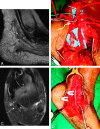MR neurography of neuromas related to nerve injury and entrapment with surgical correlation
- PMID: 20133388
- PMCID: PMC7966120
- DOI: 10.3174/ajnr.A2002
MR neurography of neuromas related to nerve injury and entrapment with surgical correlation
Abstract
MR imaging of peripheral nerves has been described in relation to abnormalities such as nerve injury, entrapment, and neoplasm. Neuroma formation is a known response to peripheral nerve injury, and here we correlate the MRN appearance of postinjury neuroma formation with intraoperative findings. We also present the MR imaging features of surgical treatment with a synthetic nerve tube and nerve wrap on postoperative follow-up imaging.
Figures








References
-
- Bencardino JT, Rosenbert ZS. Entrapment neuropathies of the upper extremity. In: Stoller DW.ed. Magnetic Resonance Imaging in Orthopaedics and Sports Medicine. Baltimore: Lippincott Williams & Wilkins; 2006
-
- Chen ZL, Yu WM, Strickland S. Peripheral regeneration. Annu Rev Neurosci 2007;30:209–33 - PubMed
-
- Aagaard BD, Maravilla KR, Kliot M. Magnetic resonance neurography: magnetic resonance imaging of peripheral nerves. Neuroimaging Clin N Am 2001;11:131–46 - PubMed
-
- Ide C. Peripheral nerve regeneration. Neurosci Res 1996;25:101–21 - PubMed
Publication types
MeSH terms
LinkOut - more resources
Full Text Sources
Medical
